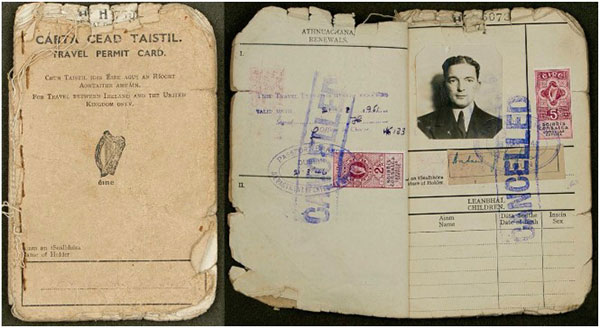Travel permits 1940–1952
Published in Issue 5 (September/October 2021), Volume 29By Fiona Fitzsimons
As the US tightened immigration controls in the 1920s and ’30s, free travel continued between Ireland and the United Kingdom. By the 1930s, Britain was the main destination for Irish emigrants. The informal arrangement that allowed free movement meant that neither state kept records of migration: we have no ships’ manifests, few visas, no alien registration cards, naturalisation or denization records of Irish migrants in the UK.
The outbreak of the Second World War put both states on a different security footing. The UK was at war, with an even greater need for Irish labour than before, while the Irish Free State, officially neutral, pursued policies that favoured the Allies. It allowed direct recruitment of citizens for war-work, and monitored and controlled their movement.
The Emergency Powers Act (1939) introduced travel permits to regulate travel between Ireland and the UK, including Northern Ireland. Workers recruited in Ireland had first to prove that there were no jobs in their area. Would-be travellers needed a permit, and an identity card issued by their local Garda station. Similarly, all Irish in the UK needed an exit permit to return home.
Certain groups of Irish were restricted from taking up war-work in the UK: any man with prior experience in agriculture or turf-cutting (these were, after all, the workers who were going to deliver Ireland’s economic self-sufficiency); anyone under the age of 22, unless travelling for training purposes (doctors and nurses); teachers; and novices and ordinands receiving religious instruction. The Act had some loop-holes: eldest sons who were heads of households in economic need were exempt from the restrictions, while young people and children under sixteen could travel freely on a parent’s or adult’s permit.
The number of new wartime emigrants from Ireland to the UK has been estimated at c. 100,000. At the end of the war these numbers increased to c. 250,000, as many Irish emigrated for work, to rebuild Britain.
The system of travel permits regulated men and women differently. Between 1940 and 1946 all Irish men and women travelling between Ireland and the UK required a permit. In 1946 regulations on women’s work were lifted and they could travel without one. At this time the requirement for a permit for Northern Ireland was also lifted. Between 1946 and 1951, Irish men still required a travel permit to work in Great Britain.
The records contain detailed evidence on origins, occupations and destinations in the UK. We find evidence of married women and some minor children. Some travel permits survive in private family papers, like the one reproduced here. Applications for travel permits from Ireland are part of the Department of Foreign Affairs collection—visa and travel facilities (DFA/4/202), NAI—closed to public inspection for a standard period of 100 years, for reasons of data protection. Applications for exit permits in the UK National Archives, Kew, are open to researchers . These are some of the only records we have of Irish migration to the UK in the twentieth century.
Fiona Fitzsimons is a director of Eneclann, a Trinity campus company, and of findmypast Ireland.

Above: The travel permit card (cover and photo page) of Andrew J. Beglan. (Lilian Beglan)
















